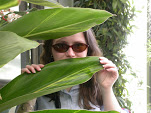All that's lovely, but what does it mean? The garden and its collection is young and still in development. They have, however, done quite a nice job with the modest grounds. I would also point out, they have a lovely library on premises, which is open to the public and full of books and periodicals on plants, gardening, and birds. Not to mention a fantastic place to escape from the heat. Richmond might as well be Savannah for the weather they get there.
But I digress. Here are some highlights of their collection.
 One of the first areas you pass through in the garden is an herb garden display, showcasing some well known as well as less known plants of medicinal interest. Washington Hawthorn (Crataegus phaenopyrum) for example, at left. Hawthorn species are native to the United States, and the berries were/are used to prepare a heart tonic, but due to my lack of experience in the matter I couldn't tell you if all species are used or only certain ones. There are ~200 species. Washington Hawthorn, despite what the name suggests, does not originate from the Pacific Northwest. According to the USDA PLANTS profile, this species is found all over the Eastern half of North America, from Florida into Canada.
One of the first areas you pass through in the garden is an herb garden display, showcasing some well known as well as less known plants of medicinal interest. Washington Hawthorn (Crataegus phaenopyrum) for example, at left. Hawthorn species are native to the United States, and the berries were/are used to prepare a heart tonic, but due to my lack of experience in the matter I couldn't tell you if all species are used or only certain ones. There are ~200 species. Washington Hawthorn, despite what the name suggests, does not originate from the Pacific Northwest. According to the USDA PLANTS profile, this species is found all over the Eastern half of North America, from Florida into Canada. They do have a modest conservatory, with a few orchids of mainly rather ordinary selections from the view of an enthusiast. Enough, though, to be educational to the novice, however. I thought this Paph. Lynleigh Koopowitz was rather attractive.
They do have a modest conservatory, with a few orchids of mainly rather ordinary selections from the view of an enthusiast. Enough, though, to be educational to the novice, however. I thought this Paph. Lynleigh Koopowitz was rather attractive. While they may have little in terms of unusual orchid species, they did, however have this nicely executed glass sculpture of a 'ghost orchid' (Dendrophylax lindenii, a.k.a. Polyrrhiza lindenii). This endangered leafless species is native to the Southwestern reaches of Florida. The plants have been under propagation for several years now, and laboratory-propagated stock are often found for sale on eBay. If you by one, please make sure it is laboratory-propagated.
While they may have little in terms of unusual orchid species, they did, however have this nicely executed glass sculpture of a 'ghost orchid' (Dendrophylax lindenii, a.k.a. Polyrrhiza lindenii). This endangered leafless species is native to the Southwestern reaches of Florida. The plants have been under propagation for several years now, and laboratory-propagated stock are often found for sale on eBay. If you by one, please make sure it is laboratory-propagated. There is a picturesque pavilion, no doubt frequently rented for weddings, surrounded by a variety of roses in varietal blocks. The most unusual to me was this Polyantha rose, 'Orange Morsdag'. I don't recall reading about Polyantha roses before, but if this one is certainly worth note with its adorable multitude of blossoms reminiscent of the Old English style. Googling it I find the shape of flowers varies among Polyantha roses, though floriferous nature and compact size is common, and they vary in their hardiness. Investigate varieties of interest before planting them in your landscape.
There is a picturesque pavilion, no doubt frequently rented for weddings, surrounded by a variety of roses in varietal blocks. The most unusual to me was this Polyantha rose, 'Orange Morsdag'. I don't recall reading about Polyantha roses before, but if this one is certainly worth note with its adorable multitude of blossoms reminiscent of the Old English style. Googling it I find the shape of flowers varies among Polyantha roses, though floriferous nature and compact size is common, and they vary in their hardiness. Investigate varieties of interest before planting them in your landscape. There were many other things of interest in the garden, including a nice variety of Japanese Maples and other trees, carnivorous plants, and woodland perennials. Overall, worth the visit when you're in the Richmond area.

3 comments:
Glad you enjoyed your visit to LGBG. One of the joys of my life is living less than a mile away! Even in this awful heat I can wonder over there and see what they have in bloom so I can think about adding it to my garden. What they have accomplished in less than 25 years is remarkable. hope you will come back in 10 years and see how it matures.
The image shown on your June 29, 2010 as Paph. Lynleigh Koopowitz is not a Paph. Lynleigh Koopowitz. Not sure what it is, could be a P. parishii.
Just a thought.
Naomi - if that is so, it was mis-marked. LG is a lovely garden, but it is clear they don't have an orchid grower on staff. The conservatory in general was sparse and mostly populated with generic, but it is also a 'young' collection, I believe. They are mostly a perennials and woody plants institution, and that portion of the grounds is better developed.
I believe their mission is education. For many garden visitors generic orchid without tag is interesting enough.
I have not been recently, actually, it would be interesting to go back and see how it has evolved.
Post a Comment